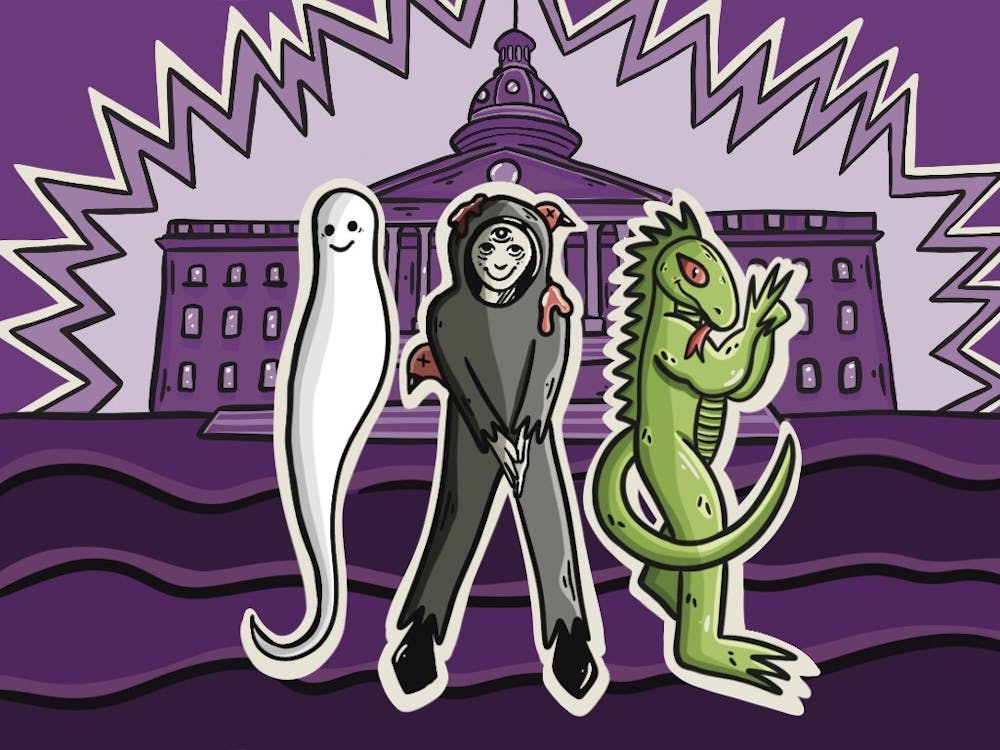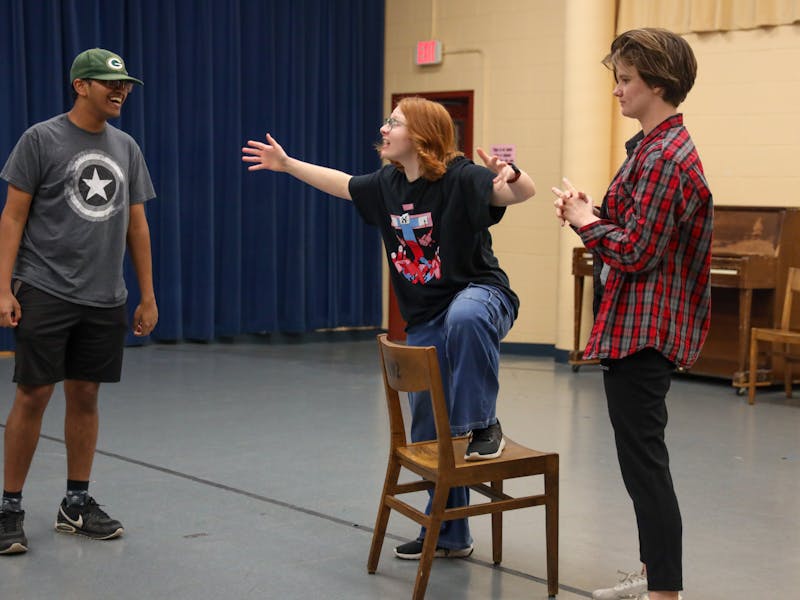Giant loblolly pines and ancient cypress trees reach up towards the cloudy South Carolina skies, their thick trunks and gnarled roots disappearing beneath the murky brown swamp water. Amongst this beautiful and mysterious swamp lies miles of winding hiking trails. Just after a warm rain, the ground is still soft and easily pliable beneath dog paws and hiking boots.
But a normal group of hikers couldn’t explain what USC student and avid hiker Jack Roddey saw imprinted into the moist dirt of this trail ten miles deep into the swamp: large humanoid footprints crossing the trail perpendicularly, emerging from the thigh-high floodplain on the right of the path and disappearing into the one on the left. From looking at the tracks, it was clear that whoever—or whatever—was taking a stroll through the deep slimy water was doing so barefoot.
Columbia, SC is steeped in legends and lore, making it a fascinating hub for paranormal enthusiasts, curious visitors and knowledgeable locals. From ghostly apparitions to scaly monsters, these supernatural folktales have created a collective consciousness that preserves a unique perspective on Columbia’s history than the one preserved in textbooks.
One such legend is that of the Lizard Man of Congaree. Could the footprints Roddey saw wading through the swamp be none other than those of this frightening creature?
“I’ve been hiking in Congaree with my dad since I was a child,” Roddey said. “He would always tell me stories about the Lizard Man and it would keep me up at night.”
“There are acres and acres of honestly uncharted forest. Surely there’s something or someone who’s undocumented or rarely seen,” Roddey later continued.
Standing at 7 feet tall with bright red eyes and glowing scaly skin, it's no wonder the legend of this bipedal humanoid lizard has been scaring people in South Carolina for decades. The Lizard Man was first spotted in June 1988 in Bishopville, SC, by 17-year-old Christopher Davis. He reported that a humanoid reptilian monster emerged from the swamp and was headed towards him as he was changing the flat tire on his car. Ever since, there have been several reports of people seeing a sharp-toothed scaly monster in and around Scape Ore Swamp, ranging from Bishopville to Columbia.
The Lizard Man lurks in the marsh and is occasionally seen by unlucky townspeople, who watch as he leaves giant scratches on road signs and cars. Now, the Lizard Man is a popular icon of Congaree National Park and the surrounding area, including Columbia, featured on merchandise and drawing in curious tourists.
While the Lizard Man might be Columbia's most famous legend, the city is enriched with many other ghosts, monsters and ghouls, their stories having been told for decades.
One tale is that of the Third Eye Man, first seen on Nov. 12, 1949 by USC student Christopher Nichols who referred to what he saw as “The Sewer Man” in his article in The Gamecock. Nichols and his friend reported seeing a strange man dressed in silver opening a manhole cover by Longstreet Theatre, climbing into the hole and pulling the manhole cover back into place.
On April 7, 1950, a university police officer reportedly found a silver man standing over two mutilated chickens near the loading dock at Longstreet Theatre. The officer turned on his flashlight and the man turned towards him, flashing the third eye on his forehead. Despite the fact that the officer never convinced the rest of the police force what he saw, the Third Eye Man became a terrorizing legend amongst USC students, keeping students out of the tunnels with his lead pipe.
The ongoing consensus is that if there is a Third Eye Man, he lives in the tunnels under the city of Columbia, also known as the Columbia catacombs. According to the Columbia Metropolitan, there are winding tunnels underneath the city that once potentially connected the State House, USC, Five Points and other historic homes. Today, the tunnels have been modified for drainage and maintenance purposes.
The legends of the Lizard Man and the Third Eye Man serve as pertinent examples of this supernatural microcosm in Columbia culture. They show how local communities can take control of a place’s history. As people reported and shared sightings of these supernatural beings throughout the past, their stories have been embedded into the collective history of the area, preserving cultural values and ensuring places like the Scape Ore Swamp and the Columbia catacombs aren’t lost in the march of time.
The tunnels themselves are a paradigm of this concept as well. No one knows for sure why these tunnels were built, but locals have speculated about their purpose since their discovery. Constructed in the early 1800s, some of these underground corridors have cypress floors, elaborate arches and are large enough for a carriage to fit through. There are many local theories about the tunnels: secret passages for state officials, part of the Underground Railroad, burial for Confederate treasure and even an escape route during the Civil War.
The creation of these theories allows people to actively participate in creating a lens in which the history of Columbia is viewed. The freedom to speculate and essentially create folklore embeds certain narratives in the collective consciousness of history for decades to come.
The Civil War is a motif seen throughout much of Columbia's legends, highlighting the large impact this event had on the city and the overarching connotation of its horror by telling it through ghost stories.
The Civil War theories of the tunnels are particularly interesting to one anthropology major, Gabe Donofrio, who has connected the Third Eye Man to the war itself, continuing the aforementioned narrative. “I always thought the description of the Third Eye Man, based on sightings you read about online, sounded like the ghost of a Confederate soldier,” he said. “They did wear gray uniforms.”
If the Third Eye Man is a ghost from the Civil War, he certainly wouldn’t be the only one on campus.
One of the most notorious haunted buildings on campus is Longstreet Theatre, which was used as a hospital and make-shift morgue during the Civil War.
“Officers would describe a kind of a cold feeling around the steps of Longstreet Theatre,” USCPD officer Eric Grabski said. “And I didn’t realize, but underneath the steps of Longstreet Theatre—you can actually go in there, it’s a sitting lounge area now—but that used to be the morgue.”
“If you actually look at those steps, on either side there’s still shutter doors that could have opened up. I would imagine they would try to keep the air flowing as best they could in there,” Grabski continued. “I had one officer, in particular. say that he would see images or what he thought were maybe some kind of ghostly figures around that point."
Between the Third Eye Man and these spooky specters, Longstreet has been preserved as a central building on campus despite not many students spending much time in this building. It remains relevant more due to its history than its current state of use.
Longstreet wasn’t the only hospital on campus. According to USC, DeSaussure College on the Horseshoe served as a hospital during the Civil War and a federal military prison during Reconstruction.
One USC student, Isabel Sans, was told when she first arrived on campus that several ghosts resided in DeSaussure—two female apparitions with alleged woeful fates inside DeSaussure’s walls.
“The first is Miss Black, daughter of a doctor killed by a group of soldiers,” Sans said. “After poisoning them, she drank the draught herself and died, trapping herself in DeSaussure. The other young woman was raped and killed by Union soldiers during the Civil War. Now she haunts the building seeking Yankee students.”
This is yet another example of how values can be fossilized through folklore. No doubt this story serves the South, villainizing Union soldiers and othering out-of-state students, thus preserving the South Carolina pride USC was built upon.
DeSaussure was also the university’s first medical school during the late 19th century.
“They found human remains behind DeSaussure in 2010,” Mark D. Smith, the collections manager at McKissick Museum said. “Turns out when I talked to the deputy coroner about that… he determined that it was the anatomy class of 1875 by the way the bones were cut.”
"[The anatomy class] would store [human remains] in whiskey barrels because they didn’t have any refrigeration,” Smith said. “When they got, I guess, too ripe, they dug a hole in the back behind DeSaussure and dumped them in, and people just forgot about it until a steam line blew.”
Some of Columbia’s ghouls are more recent though. Grabski became very familiar with the ghost of James Rion McKissick during his time as the deputy dispatch for Field Services. McKissick was one of USC’s most beloved presidents that suddenly died in 1944 during his presidency. After his death, he was buried on the Horseshoe by the South Caroliniana Library.
“When we started putting emergency call boxes and the blue lights, there was a call box right there at South Caroliniana Library near McKissick’s grave,” Grabski said. “It would go off periodically throughout the week and, inevitably, every time we would send an officer there was nothing there. We had facilities check it out and there was nothing wrong with the call box.”
However, there is no one on campus who knows McKissick’s ghost as well as Smith.
“[McKissick] was instrumental in getting this building built,” Smith said. “He died suddenly in 1944 and his coffin laid in state in the lobby of our building.”
“I started here as a student in the '80s, and there have just been little things going on ever since,” Smith continued. “I’ve heard footsteps, I’ve heard knocking, things have gotten moved, labels have fallen off, pictures have been crooked.”
However, Smith is in good humor about working with the ghost of McKissick, explaining that he is a “friendly ghost.” “When some little strange things happen, we always say J. Rion McKissick did it,” Smith said.
As these ghost stories get passed down to each new class of freshmen, people continue to take part in cataloging important people and events in the collective minds of the community. In this way, the paranormal legends of Columbia serve as more than just spooky stories: they are a vital part of the city's identity, contributing to its charm and mystique. Whether you believe in these tales or not, they undeniably add to the city's allure and continue to captivate audiences, keeping the conversation about Columbia's history alive and well.



